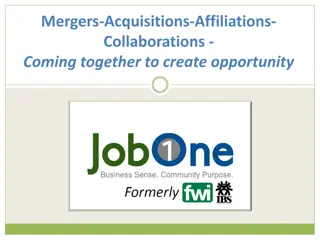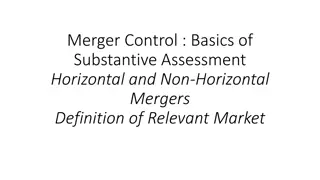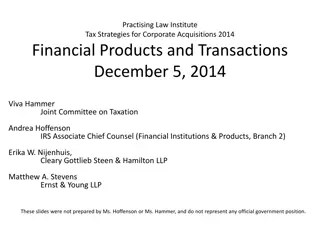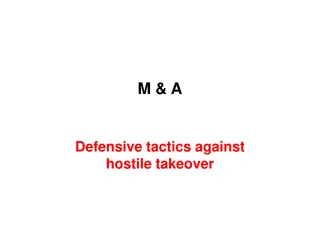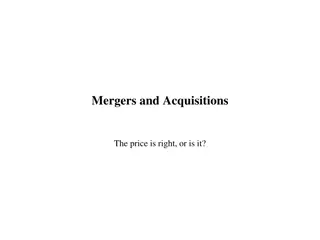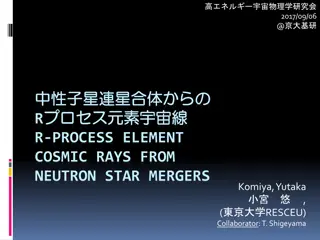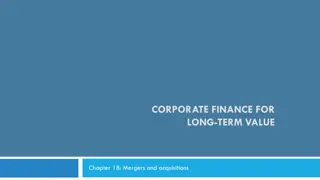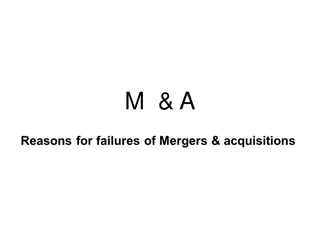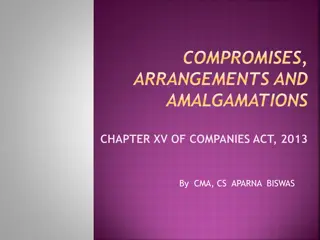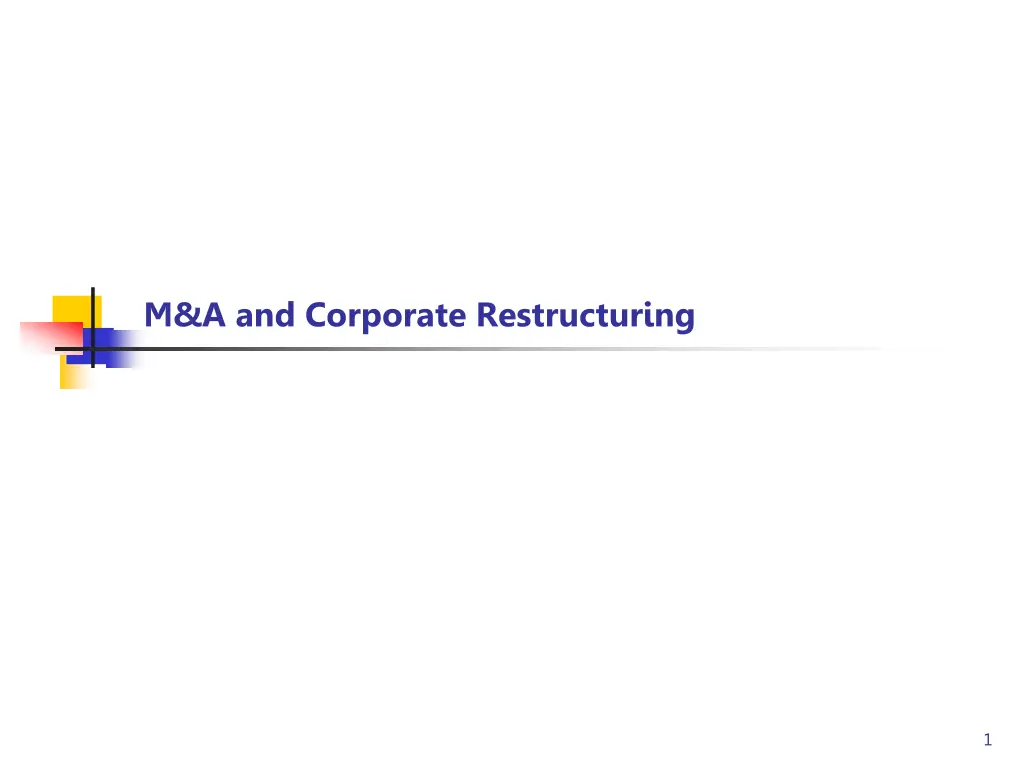
Corporate Restructuring and M&A Insights
Explore the world of mergers and acquisitions along with corporate restructuring strategies, types of M&A transactions, takeover bids process, takeover defenses, calculating a takeover offer, and more. Understand the rationale behind M&A activities, different types of synergies, reasons for engaging or not engaging in M&A deals, and how to evaluate and execute successful M&A transactions.
Uploaded on | 1 Views
Download Presentation

Please find below an Image/Link to download the presentation.
The content on the website is provided AS IS for your information and personal use only. It may not be sold, licensed, or shared on other websites without obtaining consent from the author. If you encounter any issues during the download, it is possible that the publisher has removed the file from their server.
You are allowed to download the files provided on this website for personal or commercial use, subject to the condition that they are used lawfully. All files are the property of their respective owners.
The content on the website is provided AS IS for your information and personal use only. It may not be sold, licensed, or shared on other websites without obtaining consent from the author.
E N D
Presentation Transcript
Rationale for M&A Types of Synergies Reasons Not to Engage in M&A Revenue generation synergies Personal motives Cost reduction synergies Unrelated diversification Financial synergies Increase the sustainable growth rate Taxation synergies Diversify operations Facilitate growth Maintain sales growth Strategic planning Take a company private Tax deferral 2
Types of M&A Merger Management negotiation Proxy fight Acquisition Cash offer Stock offer Mixed offer (cash and stock) Acquisition of assets 3
Take-over Bids Take-over Bid Disclosure Take-over Bid Process 5% rule 1. 2. 3. Target provides a list of security holders to the offeror. Take-over bid circulars are sent to all security holders. Circular includes the bid price, whether it is a cash or stock bid, and desired ownership percentage. Offeror cannot buy securities during the bid period. Offeror cannot pay more than the quoted price. Changes to the take-over bid circular can be made. Stock exchange keeps a record of securities offered for sale. Shares offered for sale can be withdrawn by security holders. If more securities are offered, the offeror can buy all the securities or only the securities sought on a prorate basis. 10. If insufficient securities are offered, the take-over bid may be withdrawn, or the offeror may continue with the purchase. 11. Target sends a directors circular to all security holders recommending acceptance or rejection of the bid 12. Directors circular is supported by a fairness opinion. 13. Individual directors can send additional circulars if they disagree with the opinions of the board of directors. 14. Directors must disclose benefits received for loss of position. 10% rule 2% rule 4. 5. 6. 7. 8. 9. 20% rule 4
Take-over Defenses Just say no Issuance of retractable bonds Find a better offer Generous severance payments Buy the offeror Increase management and employee ownership Standstill agreements Establish control blocks and dual- class shares Anti-take-over amendments Sell desired assets Increase financial leverage Shareholder rights plans Maximize share price Flip-in provision Flip-out provision Dead-hand provision Go private Raise anti-trust concerns Raise nationalist or security concerns 5
Calculating a Take-over Offer Discounted cash flows Market multiples Comparable companies Comparable transactions 6
Evaluating Take-over Offers VA = VB + VT + S C VA Value of acquirer post-merger VB Value of acquirer pre-merger VT Value of target S Synergies C Cash paid to target Acquirer Target Pre-merger stock price CAD 14 CAD 9 Number of common shares 70 25 Pre-merger market value CAD 980 CAD 225 Synergies CAD 95 Cash Offer CAD 10.00 per share Stock Offer - 0.75 shares of acquirer for one target share Mixed Offer CAD 5.00 per share, 0.35 share of acquirer for one target share 7
Success of M&A Track Record Successful M&A Target companies benefit greatly in take-overs Buy when the stock market is down Mergers 20% take-over premium Acquisitions 30% take-over premium Objectively estimate synergies Strictly adhere to price maximums and walkaway if prices become inflated or there are too many bidders Acquisitions return more due to the hostile bidding process and competing bids Question an M&A if the offeror s share price falls after the bid is announced Stock acquisitions are less profitable for the target Used when the offeror s share is overvalued Cash bids are higher to compensate for taxes Cash bids are used to prevail in bidding wars Avoid unrelated diversification Realize the importance of cultural fit in addition to marketing or technical fit when selecting a target Offerors on average lose money Do not alienate current employees by imposing managers on the target company Synergies are overestimated to prevail in a bidding war Managers engage in empire building Targets are smaller than offerors so overpaying is less noticed 8
Other Forms of Corporate Restructuring Sell part of a business when stock markets are overvalued to realize the best possible price for shareholders Divestitures Sell the crown jewels as a take-over defense Sell-off Equity carve-out Liquidation Comply with conditions for approval of a M&A Sell a poor performing or undervalued business unit to a group who wants to attempt a turnaround Spin-offs, split-outs, split-ups Rationale for Spin-offs, Split-outs, Split-ups Tracking shares Provide greater autonomy to a business unit so it can be managed more effectively Rationale for Divestitures Refocus on its core business Use stock options in the new business unit to better reward management performance Redeploy investment capital into faster growing areas Eliminate the effect of a poorly performing business unit from a company s overall results Sell to another company that has the resources to succeed Receive a price premium for being a pure play instead of part of a diversified company Outsource production Remove an unwanted business unit from a target firm prior to a M&A to produce a more focused company that will receive higher take-over bids Sell unneeded parts of a business acquired in a recent M&A Pay down debt built-up during previous acquisitions to avoid financial distress 9






